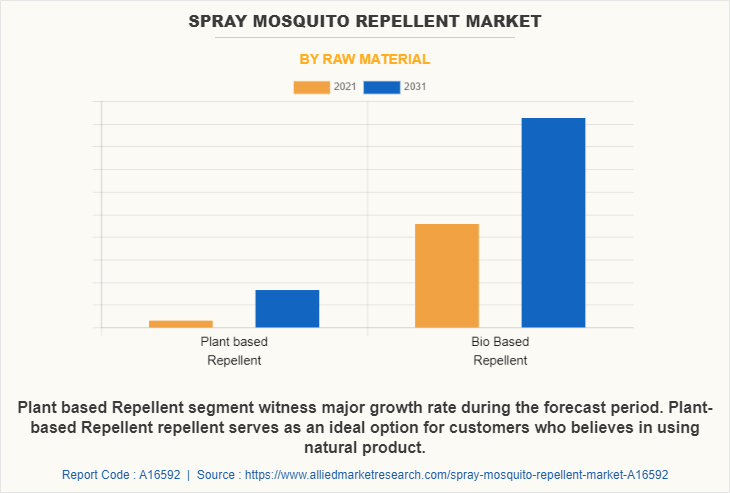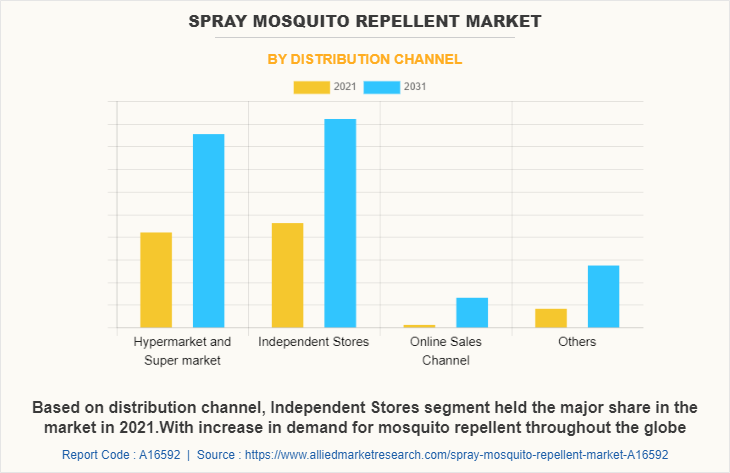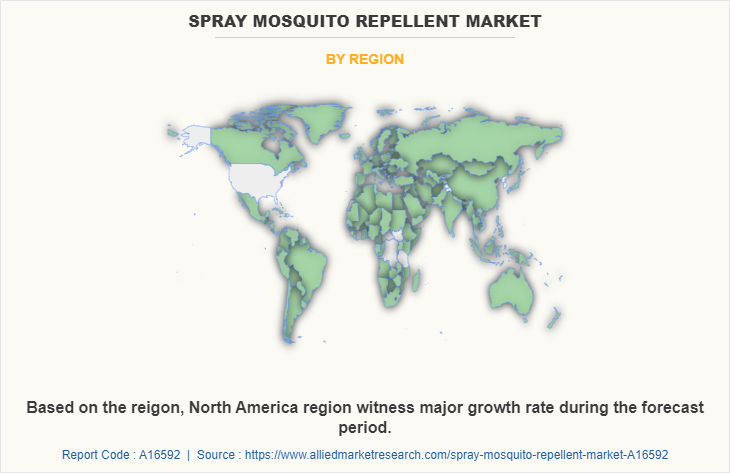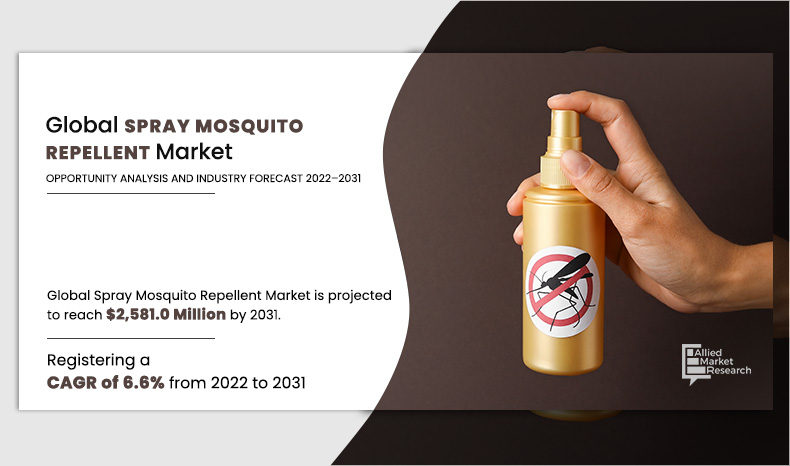The global spray mosquito repellent market was valued at $1,374.0 million in 2021, and is projected to reach $2,581.0 million by 2031, registering a CAGR of 6.6% from 2022 to 2031 Asia-Pacific region dominates the spray mosquito repellent market and is likely to remain dominant throughout the forecast period. Mosquito repellent is a chemical substance applied to skin, clothing, or other surfaces, which stops mosquitoes from landing or climbing that surface. Mosquito repellents are bifurcated into two chemical classes, namely, synthetic chemicals, such as N, N-diethyl-3-methylbenzamide (DEET), picaridin and plant-derived oils, such as oil of lemon eucalyptus and oil of citronella.It refers to aerosols available in cans with a pump, which are both body worn and non-body worn. These are used to repel mosquitoes by spraying the repellent in the air and can be effective up to 8-10 hours.
Nowadays, body worn mosquito repellent sprays have also been adopted, which are water based and include plant extracts and various aromatic oils.Currently, the market is trending with sprays based upon herbal ingredients, which is skin friendly and lasts longer than chemical-based sprays. Sprays are highly adopted in North America and Europe, owing to their high-performance efficiency of the spray mosquito repellent products. In LAMEA and Asia-Pacific, growing health consciousness is expected to boost the demand for mosquito repellent sprays. Moreover, manufacturers nowadays are focused on high-quality packaging and attractive marketing & promotional strategies, which drive the growth of the mosquito repellent market. However, presence of toxic chemicals, such as DEET, in various mosquito repellent products cause ill effects on health, which are likely to restrain the growth of the spray mosquito repellent market.
Increase in penetration of various online portals in developing regions and rise in number of offers or discounts, attract the consumer to purchase spray mosquito repellent through online channel. Moreover, online sales channel has increased the consumer reach, owing to which it has evolved as a key source of revenue for many companies. Furthermore, the online sales market is expected to expand in the near future due to rapid growth in online and mobile user customer bases in emerging markets. In addition, increase in e-commerce sales, improvements in logistics services, ease in payment options, and the facility to enter in new international markets for major brands further boost the growth of the spray mosquito repellent market.
Mosquitoes transmit a number of diseases, such as yellow fever, dengue, west nile virus, malaria, and zika virus, which are responsible for a significant number of fatalities worldwide. Due to the unexpected outbreak of the Zika virus in 43 countries, the market for mosquito repellents has recently experienced a surge in demand. In 91 countries, malaria is common, and 40% of the world's population is at risk, according to the WHO. Also, according to the WHO, an infection that starts with a mosquito bite results in roughly 2 million fatalities each year. Hence, the growth in illnesses brought on by mosquitoes is a major factor driving the market for mosquito repellent.
Due to an increase in greenhouse gas concentrations in the atmosphere, the earth's average temperature has been steadily rising over the past several years and is expected to continue to climb in the future. The ideal circumstances for mosquito breeding and increased activity are provided by hot temperatures. In some areas, it also provides a humid and damp climate, which helps such areas' populations grow. An increase in global warming would have a direct influence on the number of mosquitoes, which would increase the need of mosquito-repelling treatments.
With rising incomes and levels of literacy, the world's population is achieving better lifestyles. As a result, there are more people concerned about their health, which has raised knowledge of the numerous diseases spread by mosquitoes. Both urban and rural residents take precautions against mosquito-borne diseases, such as removing standing water, swamps, and marshes, and using spray mosquito repellents. Due of different negative effects brought on by repellents containing DEET, customers increasingly favour repellents based on natural ingredients more often.
However, the spray mosquito repellent industry would be impacted by users' growing understanding of the chemicals employed in these products, which would then influence consumers' preferences in favour of repellents made with herbal substances. The majority of synthetic insect repellents that contain dangerous substances including diethyltoluamide, allethrin, and dimethyl phthalate no longer effectively deter mosquitoes. Also, they are bad for the environment and people. Some of the most frequent negative effects of inappropriate repellent usage are allergic response and skin irritation. Allethrin is hazardous and damaging to the nervous system, respiratory system, skin, and eyes. The market for spray mosquito repellent is predicted to expand slowly due to all of the aforementioned factors involving dangerous chemicals in repellent solutions.
More chemicals than allowed are present in fake spray insect repellents, which are widely available on the market. Additionally, because the relevant authorities are not supervising the industry, many spray mosquito repellent manufacturers create bogus goods and utilise excessive amounts of chemicals, which can result in serious illnesses like cancer, windpipe disorders, birth deformities, and pregnancy issues. The selling of the current original spray mosquito repellent brands in these economies is hampered by this problem. The World Health Organization (WHO) states that manufacturers may use a maximum of.03 percent the active substance in mosquito coils to repel but not kill the leech.
On the contrary, spray mosquito repellents contain toxic ingredients like DEET that can cause breathing difficulties, skin rashes, and other health problems. Also, children and pregnant women should avoid breathing the smoke that is released when the mosquito coil is burned. With the rise in health risks associated with such chemical-based insect repellents, people have begun shifting their preferences towards herbal-based spray products. The use of sprays, lotions, and oils based on neem, citronella oil, birch tree bark, and other plant-based substances has increased in developed nations. In the upcoming years, it is anticipated that the shift in consumer preference towards insect repellents made of herbs will accelerate market expansion.
The major market participants have continually committed themselves to putting into practise successful marketing tactics designed to increase sales of various spray insect repellents. With a variety of awareness campaigns including the provision of free samples, businesses frequently become involved in raising public awareness. A few businesses, like Godrej, specifically targeted moms to increase sales of the "Good Knight" brand through advertising and instill fear in their hearts about their kids contracting a mosquito-borne sickness. This has led to an upsurge in the sales of numerous mosquito-bite prevention treatments worldwide. Future demand for spray mosquito repellents is anticipated to be driven by the effects of these creative marketing techniques.
The COVID-19 epidemic caused a drop in the spray mosquito repellent industry's growth rate, although recent years have seen a deviation as consumers have become more picky about the goods and services they buy. Because their income is uncertain, consumers have decided to spend less money on goods and services. As a result, during the pandemic, spray mosquito repellent sales have fallen. The growth of the spray mosquito repellent business around the world has been slightly hampered by the new coronavirus outbreak.
Segmental Overview
According to the spray mosquito repellent market analysis, the market is segmented into raw material and distribution channel. On the basis of raw material, the market is segmented into plant-based repellent and bio-based repellent. On the basis of distribution channel, the market is segmented into hypermarket/supermarket, independent stores, online sales, and others. The On the basis of region, the market is segmented into North America, Europe, Asia-Pacific, and LAMEA.
By Raw Material
Depending on the raw material, the bio-based repellent segment dominated the market in 2021, garnering the majority of the market share; however, the plant-based repellent is expected to grow at the highest CAGR of 7.6% from 2022 to 2031. In addition, it can be used as an alternative to chemical insect repellant because they are natural ingredients. It is possible to formulate essential oils or extracts from plants like lavender, camphor, and jasmine to create eco-friendly repellant. The items are safe to use thanks to their natural ingredients. Among the items are dabur odamus naturals, excellent knight anti-mosquito spray, and mamaerth natural mosquito spray. Consumers, who favor utilizing natural products will find that plant-based repellent is the best choice because it offers complete mosquito protection without any negative side effects. These items are generally regarded as harmless and biodegradable and do not raise any ecotoxicology concerns. The plant-based mosquito repellent sprays also have a pleasant scent and a pleasant feel on the skin. The demand for this type of repellant is increasing along with people's preference for utilizing natural products, which are thought to be the sole way to protect infants against dengue and malaria.

By Distribution channel
Depending on the distribution channel, the stainless independent stores dominated the market in 2021; however, the online sales is expected to grow at the highest CAGR of 7.7% from 2022 to 2031. In addition, Independent stores are tiny retail establishments that carry a variety of necessities such newspapers, periodicals, over-the-counter medicines, coffee, groceries, snack foods, confectionary, soft drinks, tobacco goods, and confectionery. These shops sell daily necessities and household goods, including spray mosquito repellents. Also, they provide a welcoming environment for shoppers by having an easy-to-navigate structure.

Independent retailers are making large financial investments in the modernization and modification of the facilities. Independent retailers expand the mosquito repellent business by reaching the untapped rural areas in response to the rising demand for repellent across the globe. Because there are no other distribution routes in rural areas, small retailers can benefit by attracting rural customers. Also, small shops offer customers looking for insect repellent flexible and trustworthy solutions.
By Region
Region wise, Asia-Pacific dominated the market in 2021, garnering a market share of 49.8%. The two largest developing nations in the Asia-Pacific area, China and India, have sanitation issues, which encourage mosquito breeding and promote sales of spray insect repellent products. Yet, new items with creative designs have emerged; an example of an inventive item is a waterproof anti-mosquito wristband that works well to keep mosquitoes at bay. The item comes in a variety of colors and brands. Moreover, LG Technology introduced a mosquito-repellent TV in India last year. When engaged, the product's Ultra Sonic component chases mosquitoes away. This region's market is expected to grow as a result of increased government and health official awareness of the need to control mosquito-borne diseases.

Competitive Analysis
The players operating in the spray mosquito repellent industry have adopted product launch and business expansion as their key developmental strategies to expand their market share, increase profitability, and remain competitive in the market. The key players profiled in this report include 3M, BASF SE, Dabur International Ltd, Godrej Consumer Products Limited, Henkel AG & Co. KGaA, Johnson & Johnson, Reckitt Benckiser Group plc, S.C. Johnson & Son Inc, Sawyer Products, Inc, and Spectrum Brands Holdings.
Some Examples of Partnership in the Spray Mosquito Repellent Market
- In September 2021, Reckitt Benckiser Group PLC. formed a partnership with Pakistan International Airlines (PIA) in order to boost the hygiene facilities of the airlines and to further its business prospective.
- In April 2021, Reckitt Benckiser Group PLC. formed a partnership with The Tourism Authority of Thailand (TAT) in order to boost the hygiene facilities in the Thailand tourism industry and to further its business prospective.
- In February 2021, Reckitt Benckiser Group PLC. formed has formed a partnership with The Football Association (FA) in order to boost the hygiene facilities of the football fields and the players and to further its business prospective.
Some Examples of Expansion in the Spray Mosquito Repellent Market
- In May 2022, Spectrum Brands Holdings, Inc. unveiled new packaging for its Cutter insect repellant products in order to appeal to and capture a larger audience base for its insect repellant products.
Key Benefits For Stakeholders
- This report provides a quantitative analysis of current trends, estimations, and dynamics of the global spray mosquito repellent from 2021 to 2031 to identify the prevailing market opportunities.
- The Porter’s five forces analysis highlights the potency of the buyers and suppliers to enable stakeholders to make profit-oriented business decisions and strengthen their supplier–buyer network.
- In-depth analysis of the market segmentation assists to determine the prevailing market opportunities.
- Major countries in each region are mapped according to their revenue contribution to the global industry.
- The market player positioning segment facilitates benchmarking while providing a clear understanding of the present position of the key market players.
- The report includes analyses of the regional as well as global market, key players, market segments, application areas, and growth strategies.
Spray Mosquito Repellent Market Report Highlights
| Aspects | Details |
| Market Size By 2031 | USD 2.6 billion |
| Growth Rate | CAGR of 6.6% |
| Forecast period | 2021 - 2031 |
| Report Pages | 280 |
| By Raw Material |
|
| By Distribution Channel |
|
| By Region |
|
| Key Market Players | S. C. Johnson and Son, Jyothy Laboratories Ltd. (JLL), Johnson and Johnson Services, Inc, Himalaya Herbals, Reckitt Benckiser Group plc., godrej consumer products limited, DABUR INTERNATIONAL LTD, Spectrum Brands Holdings, Sawyer Products, Inc, Coghlan's Ltd |
Analyst Review
Asia-Pacific holds the largest share in the global spray mosquito repellent market, owing to higher demand for spray mosquito repellent products in countries such as China and India. However, the market is at a nascent stage in the rural areas due to lower level of health and hygiene consciousness. Recently, countries in America and Africa have witnessed a surge in the demand for spray mosquito repellent products due to the outbreak of Zika virus caused by Aedes mosquito. Increase in demand for herbal and organic ingredient-based products offer lucrative business opportunity for the players operating in the market.
The developing markets are characterized by higher adoption of lower priced spray mosquito repellent products. Penetration level of mosquito repellent sprays prepared from organic and herbal ingredients is higher in developed markets such as North America and Europe. Moreover, the demand for such high-end products is on rise consistently in developing markets, owing to factors such as rise in literacy levels and increase in awareness campaigns run by government and players operating in the industry. The industry has witnessed the entry of numerous small players, who manufacture and market innovative spray mosquito repellent products, since recent past.
Increase in penetration of various online portals in developing regions and rise in number of offers or discounts, attract the consumer to purchase spray mosquito repellent through online channe, and health concerns are also on rise leading to an increase in the level of awareness toward various mosquito-transmitted diseases are the upcoming trends of Spray Mosquito Repellent Market in the world.
Independent Stores is the leading distribution channel of Spray Mosquito Repellent Market.
Asia-Pacific is the largest regional market for Spray Mosquito Repellent.
The global spray mosquito repellent market was valued at $1,374.0 million in 2021, and is projected to reach $2,581.0 million by 2031, registering a CAGR of 6.6% from 2021 2022 to 2031.
The key players profiled in this report include 3M, BASF SE, Dabur International Ltd, Godrej Consumer Products Limited, Henkel AG & Co. KGaA, Johnson & Johnson, Reckitt Benckiser Group plc, S.C. Johnson & Son Inc, Sawyer Products, Inc, and Spectrum Brands Holdings
Loading Table Of Content...




